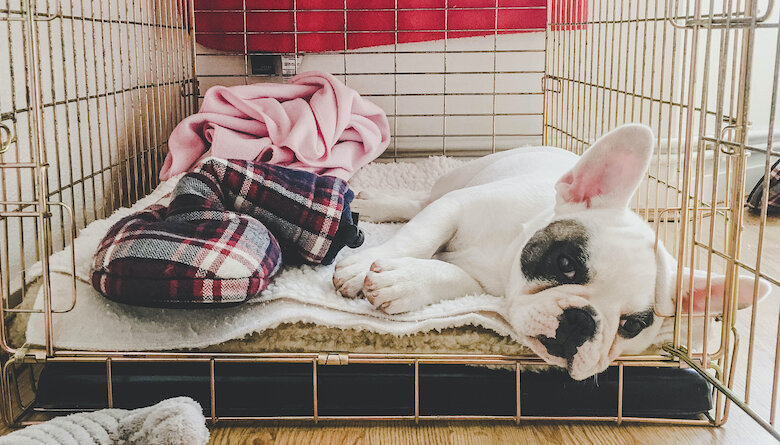How to Help Your Crying Puppy
Gone are the days when standard advice was to ignore a crying puppy. “Ignore him,” we said, “until he stops crying. If you go to him while he’s crying, you’ll reinforce him and teach him to cry more.” That’s horrid advice and I regret that ages ago I was guilty of saying it to clients.
Now that competent, educated dog training and behavior professionals have a much better understanding of the science of behavior and learning, we won’t tell you to ignore your pup’s cries. You must take action when your pup is in distress. That’s what his cries are – he’s communicating to you that he’s distressed – sometimes very distressed. (Note: This does not apply to “demand barking” – that requires a different response.)
While some puppies survive having their cries ignored and grow into normal, healthy adult dogs, others suffer with stress-related behavioral issues for the rest of their lives, including separation anxiety, due at least in part to not having their needs met when they were so desperate for help. So what should you do when your puppy cries? He’s crying for help. Help him.
Why is puppy crying?
When a puppy arrives at his new home, his world has turned upside down. His mother and siblings are gone. The familiar sights, sounds and smells of his birth home are gone – replaced with an alien environment. Even if he came from a responsible breeder who helped prepare him for this life change (sadly, a small percentage of possible puppy sources) the stress of rehoming may still trigger distress behaviors.
It’s critically important to take things slowly. Your pup may have never been alone before, ever. Being left alone now could be horribly traumatic, especially if you ignore his pleas for help. Your best approach is prevention. Assume your pup has never been crated or left alone, and plan on staying near him at first. Even if he has been previously crate-trained, the stress of relocating to your home can contribute to panic attacks.
How to help your puppy
Whether you are faced with a newly-arrived puppy or one who’s been in your home for a while, here’s what you need to do:
- Why is he crying. What’s stressing him? After identifying his stressor(s), figure out how to make them go away. (Go to: https://www.whole-dog-journal.com/training/stressed-out/)
- Anticipate when he’s likely to stress-cry, and pre-empt the crying by engaging him in some other activity, food toy, or providing company.
- Keep him near you, and gradually acclimate him to being alone. Isolation is a huge stressor for a puppy!
- Spend time acclimating him to his crate by playing crate games, preferably starting with his first day home (but it’s never too late). (Go to: https://www.whole-dog-journal.com/training/dog-crate-expectations/)
- If he is stressed by crating, use an exercise pen alternative (a collapsible wire pen) for confinement.
- If you cannot determine his stressors and alleviate his crying, engage the services of a qualified professional force-free behavior consultant to help you, sooner, not later.
How to get a puppy to stop crying at night
A pup’s first night home can be make-or-break time. If he adapted well to his crate during your first-day crate games, you can probably crate him in your room for the night. Do not, under any circumstances, crate him away in a room all by himself. You have to hear him when he cries to go to the bathroom. Get up and take him out. Crating him in your room also saves him from feeling abandoned. If he’s stressed about the crate, use an exercise pen that you can set next to your bed with your arm draped over the edge if necessary, to assure him he’s not alone.
Give him a good bout of puppy playtime before bed, a last bathroom trip and time to settle before the two of you retire for the night. Have his crate or pen where he can see you. A microwave-heated towel can provide comfort for him. He may fuss for a moment or two. As long as it doesn’t escalate and he settles quickly, you can ignore brief fussing. If it starts increase to distress crying, intervene. Hang your hand in front of his crate or into his pen so he has company. Over time (days, weeks) you should gradually be able to remove your hand without causing distress.
The same philosophy holds true for other times, long after your first night is behind you – in fact, for the rest of his life. A distressed, crying dog needs to be helped, not ignored. Figure out why he’s upset, and determine what you need to do to alleviate his stress. Intervene when he’s distressed. He’s crying for help. Help him.
Read Next: Socializing Your Puppy





